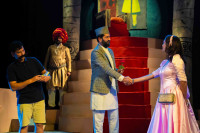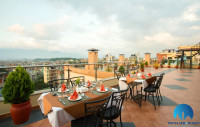Culture & Lifestyle
The forgotten town of Handigaun
One of the Kathmandu Valley’s oldest urban settlements, Handigaun is now an almost forgotten destination, remembered only during its jatras..jpg&w=900&height=601)
Srizu Bajracharya
It’s overcast as Bijay Karmacharya takes a walk around his hometown of Handigaun. Although it’s just 1.6 km northwest from urban Kathmandu, the town’s milieu is calm and quiet. A quick walk around reveals that the town’s façade is made up of almost all commercial businesses and restaurants—only faint traces of its almost 2000-year-old history remain.
“Despite its history, Handigaun doesn’t have the aura of a cultural, historical town. The houses are concrete and the roadway cleanly pitched,” says 45-year-old Karmacharya, a priest of Tudaldevi Mandir, an important temple of Handigaun.
There is nothing evidently quaint about Handigaun: there is not much farmland left, the settlement is all but concrete and roads have replaced temples. Unlike other Newar towns, like Bungamati, Sankhu, Khokhana and Patan, it doesn’t readily demonstrate a cultural lifestyle—its character is uncertain.
Historians, however, have traced the city’s history back to the Lichhavi period, which dates back to around 250 AD. But the few remnants of this rich history are difficult to trace here, given how its distinctive identity has suffered at the hands of urbanisation.
.jpg)
Going down with history
Handigaun never received its due glory for a couple of reasons, says Karmacharya. “One, the concerned authorities neglected Handigaun’s heritage for too long, even the Nepal Tourism Board,” says Karmacharya. “Two, Handigaun, despite having tourism potential, hasn’t been explored much. Three, even locals have never shown much interest in conserving the old, although they were continuing the age-long traditions faithfully. Four, our numbers are too small to make much effort for conservation,” he adds.
During the two major festivals, Gahana Khojne Jatra and Satya Narayan Jatra, also known as the Kahi Nabhaeko Handigaun Jatra, the town recaptures its spirit, however. There is baaja playing in the streets, the air is filled with the smell of charred choila and incense, sallis are filled with aila—reminding people of the city it once was. The younger generation invigorates the festive mood too, but once celebrations recede, Handigaun loses its charm once more.
“These festivals are centuries old, even older than the ones celebrated in the Valley’s other towns and they are celebrated with much opulence, through support from the Guthi Sansthan and local communities,” says Surya Lal Prajapati, a local of Dathutole, Handigaun. More than five generations of Prajapati’s family have lived in Handigaun. “However, besides the fame of the jatras, Handigaun’s history is forgotten. And much of it is because people are chasing after the new. There is so much potential for Handigaun but visitors rarely come,” says Prajapati.
.jpg)
Over the years, a lack of communal concern and government apathy have led to the decline in conservation efforts of this ancient town. Another reason Handigaun lost much of its architecture was because of earthquakes, says Prajapati. “The people of Handigaun were displaced multiple times, once, due to an uncontrolled fire, during the reign of Raja Radhav Deva in 879, and then later due to devastating earthquakes, in 1344 and 1465. It is believed it was during the earthquake that we lost the palace, Kailashkut Bhavan,” says Prajapati, who is also the former chairman of Ward no 5.
In Handigaun, almost every local knows the town’s rich history, and the uniqueness that the country has failed to acknowledge. In tales shared by the elderly, the young know by heart the story behind the Jatras. One tale is of a woman who suffered labour for 12-years straight for disrespecting Narayan (Vishnu). Unable to see the misfortune of the woman, the locals of Handigaun tried to persuade Lord Narayana to lift the curse through a celebration like no other, which became the Kahi Nabhayeko Handigaun Jatra.
Another long tale that never gets old among the locals is of Tudaldevi losing her jewels in Gahana Pokhari while swimming with her sisters Mahalaxmi, Manamaiju, and Nuwakotdevi—the reiteration of the story every year became the Gahana Khojne Jatra. Many also know of the Lichhavi lineage of Handigaun, of the missing Kailashkut Bhawan built by Lichhavi King Amshuverma and of the many deities sculpted during the period.
“The evidence is that the sculptures of deities don’t bear any articulate features like those built during the Malla era,” says Karmacharya. “It was during the Licchavi era that this town’s culture, architecture and socio-political structure developed, which was continued in the Malla period more skillfully,” he says.
And while the history of the Mallas remains fresh in people’s mind, with some of the Malla architecture still intact, the history of the Lichhavi period has been forsaken, says Prajapati. “It wasn’t deliberate of course, and it just became so because there isn’t much that remains from the Lichhavi period,” he says.
Through the years, Handigaun’s original name also changed with time. “It is said the name of Handigaun was originally ‘Hari’ gaun, meaning Narayan’s village, which went on to become Handigaun. Many also say the name could have come from the earthen pot makers, the Prajapatis, who are believed to be the original inhabitants of the place. They used to make ‘handi’ and people say the name might have come from there,” says Karmacharya. “Some also used to call the place Nardes, Narayan’s country.”
.jpg)
According to Sudarshan Raj Tiwari, a cultural historian, Handigaun is one of the earliest known urban settlements of the Kathmandu Valley. Once upon a time, it used to be the capital of the Valley too, he says. The place also houses one of the oldest shrines, Satya Narayan Temple, with a domed design, a prevalent feature in the Lichhavi monuments. In the Amshuverma inscription that is now placed at the Handigaun Dabali, right before the stairs that takes one to the Satya Narayan temple, the engraving reads the daily routine of the King besides also establishing the names of the important deities.
“The inscription’s presence itself is evidence the Kailashkut Bhavan was somewhere in Handigaun,” says Prajapati.
At Handigaun there’s also a significant number of shivalingams, showing how the town is inherently a Hindu community. There the courtyard-style bahal, where Newar communities live, is called ‘nanhi’, and instead of chaityas, one will find Shiva lingas, an iconic representation of the Hindu deity Shiva. But with time, the landscape of these nanhis too have changed—they are less brick and more concrete.
Resurgence of Handigaun’s history
According to Professor Hari Sarmah who has worked in the tourism sector for three decades, a place’s tourism potential can only be explored when the local community is involved and driven in establishing the place as a destination of value. “Without the contribution of the local community, you cannot plan a tourism product. Because it is the local participation that pushes the government and necessary authorities to make initiations,” says Sarmah. “Look at how Thimi has developed in just a decade with the participation of the locals there.”
Today, Handigaun locals have realised what they had and lost. With a renewed vibrancy to revive and protect their tangible and intangible heritage, in support of the provincial government system, Handigaun is amending its ways.
“The community has become more involved to protect its culture and inheritance,” says Karmacharya. “And the timing is just right because the government also sees a potential in Handigaun today, and the Kathmandu Metropolitan City, Department of Archaeology, along with Handigaun Sampada Samaj, has been working to restore the important monuments of this historic town.”
Many also believe once researchers will be able to track the ancient palace, Kailakut Bhavan, Mangriha, the place will itself regain its lost recognition. “While that work goes on, alongside, we have been creating travel brochures and tourism related literature, because we also need to connect with other tourism institutions to promote the town,” says Tiwari, author of The Brick and the Bull: An Account of Handigaun, the Ancient Capital of Nepal.
.jpg)
At present, many construction projects on Handigaun’s temples are underway. “We are restoring and mending important monumental structures of Handigaun, like the Gorakhnath temple, Dhana Ganesh temple, Satya Narayan Mandir, and Mann Maneshwori temple,” said Ramesh Dangol, chairman of Ward No. 5, Handigaun. The organisation has already started constructing four entrance doors to Handigaun near Gahana Pokhari, Kotatol, Bhuteshwor Mandir, and one at the south-west Dathku chowk. And locals believe this will help mark the place with cultural significance.
And with the strengthening of revival projects, the locals have also gotten into action to reinstate Handigaun. The recent uproar during the ongoing restoration of Panche Dhara says much about the awakening they have undergone in the past few years. “There was some misunderstanding; the contractor’s men dismantled the five hitis without understanding what they meant, culturally and historically. And people were angry about how the concerned authorities let that happen,” said Dangol. The concerned authorities, however, have now taken things into consideration and have made sure that the old iconic structures will be handled with care during all construction.
“There is so much cultural experience Handigaun can give, and maybe in the future we will be able to do that. But for now we need more support than ever from the concerned authorities and from the locals,” says Karmacharya, as he ends the walk at Gahana Pokhari where men are busy cleaning the pond for the upcoming Gahana Khojne Jatra. “We don’t want people just to remember us for our festivals, surely not just for the urban proverb, ‘Kahi nabhaeko, Handigaun ma [Nowhere else but in Handigaun],” he says.




 13.12°C Kathmandu
13.12°C Kathmandu
.jpg&w=200&height=120)














